浅议英国茶文化及英语“茶”语
- 格式:pdf
- 大小:216.51 KB
- 文档页数:2
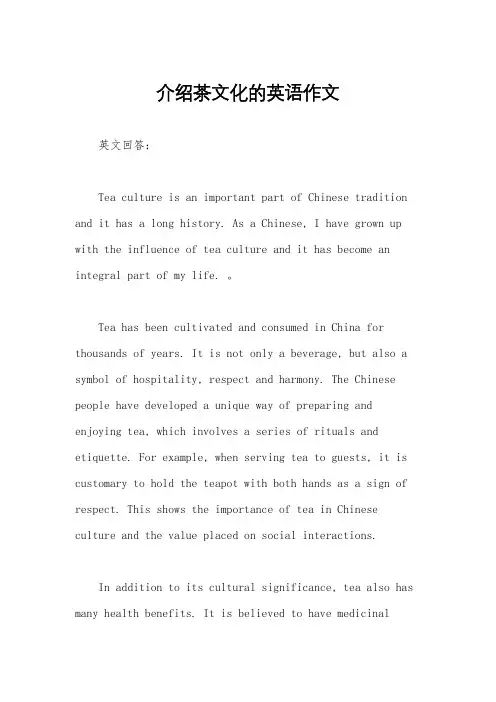
介绍茶文化的英语作文英文回答:Tea culture is an important part of Chinese tradition and it has a long history. As a Chinese, I have grown up with the influence of tea culture and it has become an integral part of my life. 。
Tea has been cultivated and consumed in China for thousands of years. It is not only a beverage, but also a symbol of hospitality, respect and harmony. The Chinese people have developed a unique way of preparing and enjoying tea, which involves a series of rituals and etiquette. For example, when serving tea to guests, it is customary to hold the teapot with both hands as a sign of respect. This shows the importance of tea in Chinese culture and the value placed on social interactions.In addition to its cultural significance, tea also has many health benefits. It is believed to have medicinalproperties and is often used in traditional Chinesemedicine to treat various ailments. For example, green teais known for its antioxidant properties, while oolong teais believed to aid in digestion. 。
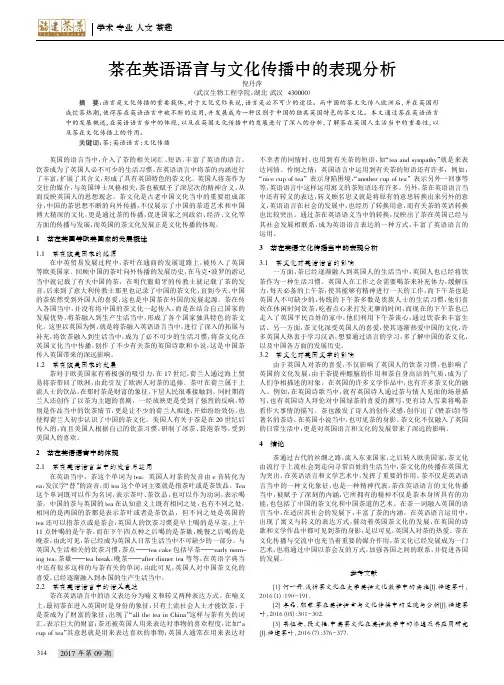
2017年第09期学术专业人文茶趣英国的语言当中,介入了茶的相关词汇、短语,丰富了英语的语言。
饮茶成为了英国人必不可少的生活习惯,在英语语言中将茶的内涵进行了丰富,扩展了其含义,形成了具有英国特色的茶文化。
英国人将茶作为交往的媒介,与英国绅士风格相关,茶也被赋予了深层次的精神含义,从而反映英国人的思想观念。
茶文化是古老中国文化当中的重要组成部分,中国的茶思想不断的向外传播,不仅展示了中国的茶道艺术和中国博大精深的文化,更是通过茶的传播,促进国家之间政治、经济、文化等方面的传播与发展,而英国的茶文化发展正是文化传播的体现。
1茶在英国等欧美国家的发展概述1.1茶在欧美国家的起源在中英贸易发展过程中,茶叶在通商的发展道路上,被传入了英国等欧美国家。
回顾中国的茶叶向外传播的发展历史,在马克·波罗的游记当中就记载了有关中国的茶,在明代葡萄牙的传教士就记载了茶的发音,后来到了意大利传教士那里也记录了中国的茶文化,直到今天,中国的茶依然受到外国人的喜爱,这也是中国茶在外国的发展起源。
茶在传入各国当中,并没有将中国的茶文化一起传入,而是在结合自己国家的发展优势,将茶融入到生产生活当中,形成了各个国家独具特色的茶文化。
这里以英国为例,就是将茶融入英语语言当中,进行了深入的拓展与补充,将饮茶融入到生活当中,成为了必不可少的生活习惯,将茶文化在英国文化当中传播,创作了不少有关茶的英国诗歌和小说,这是中国茶传入英国带来的深远影响。
1.2茶在欧美国家的发展茶对于欧美国家有着极强的吸引力,在17世纪,荷兰人通过海上贸易将茶带回了欧洲,由此引发了欧洲人对茶的追捧。
茶叶在荷兰属于上流人士的饮品,在那时茶是财富的象征,下层人民很难接触到。
同时期荷兰人还创作了以茶为主题的喜剧,一经放映更是受到了强烈的反响,特别是作品当中的饮茶情节,更是让不少的荷兰人痴迷,开始纷纷效仿,也使得荷兰人初步认识了中国的茶文化。
美国人有关于茶是在20世纪后传入的,而且美国人根据自己的饮茶习惯,研制了冰茶、袋泡茶等,受到美国人的喜欢。
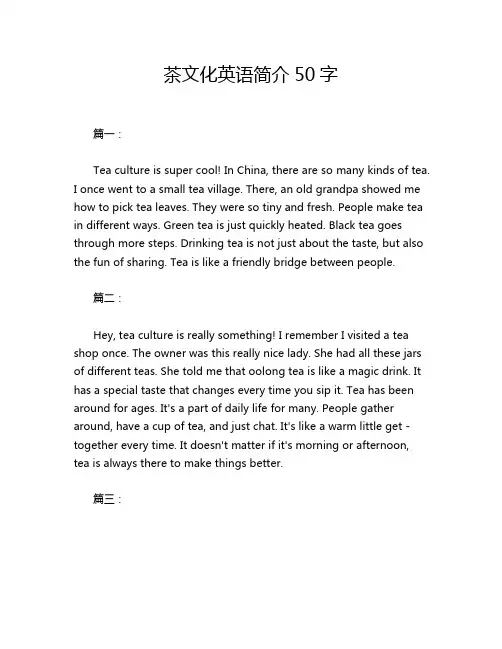
茶文化英语简介50字篇一:Tea culture is super cool! In China, there are so many kinds of tea.I once went to a small tea village. There, an old grandpa showed me how to pick tea leaves. They were so tiny and fresh. People make tea in different ways. Green tea is just quickly heated. Black tea goes through more steps. Drinking tea is not just about the taste, but also the fun of sharing. Tea is like a friendly bridge between people.篇二:Hey, tea culture is really something! I remember I visited a tea shop once. The owner was this really nice lady. She had all these jars of different teas. She told me that oolong tea is like a magic drink. It has a special taste that changes every time you sip it. Tea has been around for ages. It's a part of daily life for many. People gather around, have a cup of tea, and just chat. It's like a warm little get - together every time. It doesn't matter if it's morning or afternoon, tea is always there to make things better.篇三:Well, tea culture is quite interesting. I was at a friend's place once, and his mom was making tea. She had this special tea set. The teapot was so cute, like a little round belly. She poured the hot water over the tea leaves gently, like she was taking care of a baby. Different regions have their own tea traditions. Some like it strong, some like it mild. But everyone loves that moment when they take the first sip of a freshly made cup of tea. It's like a little celebration in your mouth.。
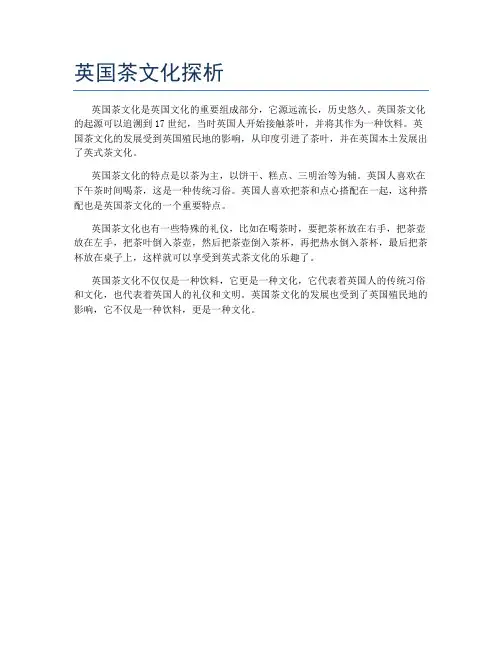
英国茶文化探析
英国茶文化是英国文化的重要组成部分,它源远流长,历史悠久。
英国茶文化的起源可以追溯到17世纪,当时英国人开始接触茶叶,并将其作为一种饮料。
英国茶文化的发展受到英国殖民地的影响,从印度引进了茶叶,并在英国本土发展出了英式茶文化。
英国茶文化的特点是以茶为主,以饼干、糕点、三明治等为辅。
英国人喜欢在下午茶时间喝茶,这是一种传统习俗。
英国人喜欢把茶和点心搭配在一起,这种搭配也是英国茶文化的一个重要特点。
英国茶文化也有一些特殊的礼仪,比如在喝茶时,要把茶杯放在右手,把茶壶放在左手,把茶叶倒入茶壶,然后把茶壶倒入茶杯,再把热水倒入茶杯,最后把茶杯放在桌子上,这样就可以享受到英式茶文化的乐趣了。
英国茶文化不仅仅是一种饮料,它更是一种文化,它代表着英国人的传统习俗和文化,也代表着英国人的礼仪和文明。
英国茶文化的发展也受到了英国殖民地的影响,它不仅是一种饮料,更是一种文化。
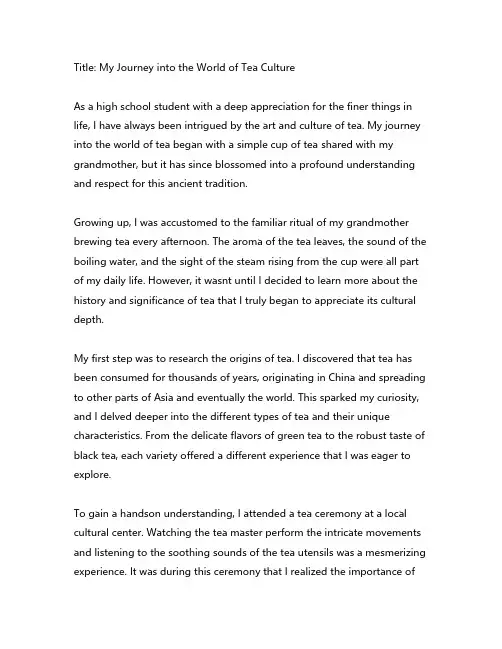
Title: My Journey into the World of Tea CultureAs a high school student with a deep appreciation for the finer things in life, I have always been intrigued by the art and culture of tea. My journey into the world of tea began with a simple cup of tea shared with my grandmother, but it has since blossomed into a profound understanding and respect for this ancient tradition.Growing up, I was accustomed to the familiar ritual of my grandmother brewing tea every afternoon. The aroma of the tea leaves, the sound of the boiling water, and the sight of the steam rising from the cup were all part of my daily life. However, it wasnt until I decided to learn more about the history and significance of tea that I truly began to appreciate its cultural depth.My first step was to research the origins of tea. I discovered that tea has been consumed for thousands of years, originating in China and spreading to other parts of Asia and eventually the world. This sparked my curiosity, and I delved deeper into the different types of tea and their unique characteristics. From the delicate flavors of green tea to the robust taste of black tea, each variety offered a different experience that I was eager to explore.To gain a handson understanding, I attended a tea ceremony at a local cultural center. Watching the tea master perform the intricate movements and listening to the soothing sounds of the tea utensils was a mesmerizing experience. It was during this ceremony that I realized the importance ofmindfulness and respect for the teamaking process.As I continued to learn, I also began to experiment with brewing tea at home. I practiced different techniques, such as steeping the leaves at various temperatures and for different durations, to achieve the desired flavor. This process taught me the value of patience and attention to detail, qualities that are essential not only in tea brewing but also in life.Moreover, I discovered the health benefits of tea, which include its antioxidant properties and potential to boost the immune system. This revelation motivated me to incorporate tea into my daily routine, not just for its taste but also for its wellness benefits.My exploration of tea culture has not only expanded my knowledge but also enriched my life. It has taught me to appreciate the beauty in simplicity and the importance of taking the time to savor lifes moments. As I continue to learn and grow, I look forward to sharing my passion for tea with others and preserving this timeless tradition for future generations.。
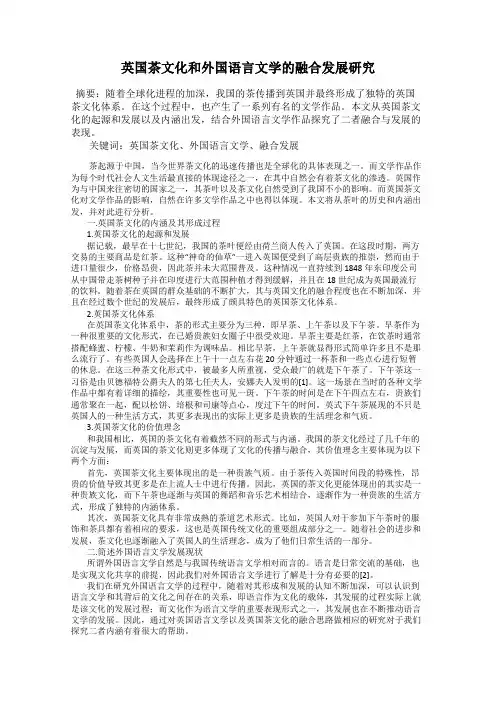
英国茶文化和外国语言文学的融合发展研究摘要:随着全球化进程的加深,我国的茶传播到英国并最终形成了独特的英国茶文化体系。
在这个过程中,也产生了一系列有名的文学作品。
本文从英国茶文化的起源和发展以及内涵出发,结合外国语言文学作品探究了二者融合与发展的表现。
关键词:英国茶文化、外国语言文学、融合发展茶起源于中国,当今世界茶文化的迅速传播也是全球化的具体表现之一。
而文学作品作为每个时代社会人文生活最直接的体现途径之一,在其中自然会有着茶文化的渗透。
英国作为与中国来往密切的国家之一,其茶叶以及茶文化自然受到了我国不小的影响。
而英国茶文化对文学作品的影响,自然在许多文学作品之中也得以体现。
本文将从茶叶的历史和内涵出发,并对此进行分析。
一.英国茶文化的内涵及其形成过程1.英国茶文化的起源和发展据记载,最早在十七世纪,我国的茶叶便经由荷兰商人传入了英国。
在这段时期,两方交易的主要商品是红茶。
这种“神奇的仙草”一进入英国便受到了高层贵族的推崇,然而由于进口量很少,价格昂贵,因此茶并未大范围普及。
这种情况一直持续到1848年东印度公司从中国带走茶树种子并在印度进行大范围种植才得到缓解,并且在18世纪成为英国最流行的饮料。
随着茶在英国的群众基础的不断扩大,其与英国文化的融合程度也在不断加深,并且在经过数个世纪的发展后,最终形成了颇具特色的英国茶文化体系。
2.英国茶文化体系在英国茶文化体系中,茶的形式主要分为三种,即早茶、上午茶以及下午茶。
早茶作为一种很重要的文化形式,在已婚贵族妇女圈子中很受欢迎。
早茶主要是红茶,在饮茶时通常搭配蜂蜜、柠檬、牛奶和茉莉作为调味品。
相比早茶,上午茶就显得形式简单许多且不是那么流行了。
有些英国人会选择在上午十一点左右花20分钟通过一杯茶和一些点心进行短暂的休息。
在这三种茶文化形式中,被最多人所重视,受众最广的就是下午茶了。
下午茶这一习俗是由贝德福特公爵夫人的第七任夫人,安娜夫人发明的[1]。
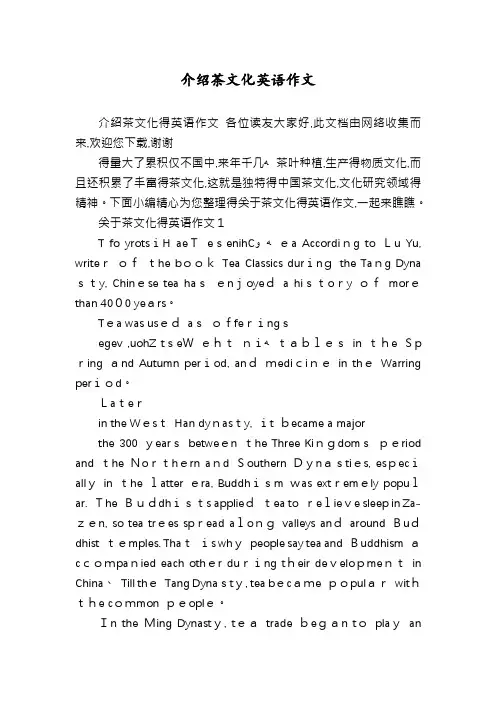
介绍茶文化英语作文介绍茶文化得英语作文各位读友大家好,此文档由网络收集而来,欢迎您下载,谢谢得量大了累积仅不国中,来年千几ﻪ茶叶种植,生产得物质文化,而且还积累了丰富得茶文化,这就是独特得中国茶文化,文化研究领域得精神。
下面小编精心为您整理得关于茶文化得英语作文,一起来瞧瞧。
关于茶文化得英语作文1T fo yrotsiH aeTesenihCﻭﻪea According to Lu Yu, writerofthe bookTea Classics duringthe Tang Dyna sty, Chinese tea hasenjoyeda history ofmorethan 4000 years。
Tea was usedasofferingsegev ,uohZ tseWehtniﻪtablesin the Sp ring and Autumn period, andmedicinein theWarring period。
Laterin the WestHan dynasty, it became a majorthe 300 yearsbetween the Three Kingdomsperiod and the Northern and Southern Dynasties, especiallyin the latter era, Buddhism was extremely popular. The Buddhists appliedtea to relieve sleep in Za-zen, so tea trees spread alongvalleys andaround Buddhist temples. Thatis whypeople say tea and Buddhism accompanied each other during their developmentin China、Till theTang Dynasty, tea became popularwiththe common people。
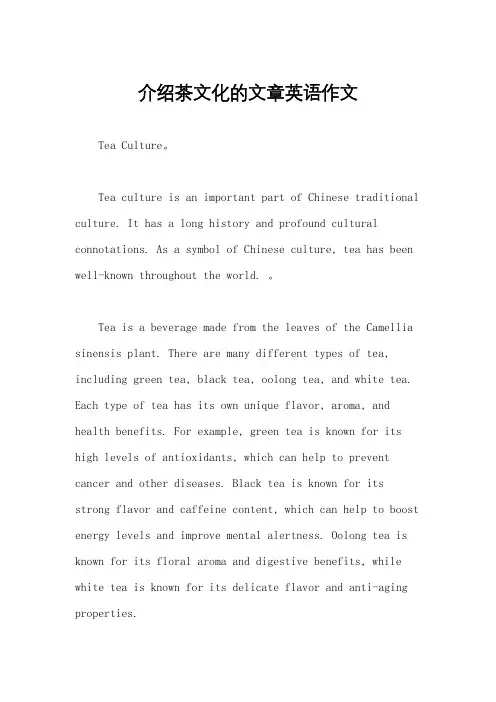
介绍茶文化的文章英语作文Tea Culture。
Tea culture is an important part of Chinese traditional culture. It has a long history and profound cultural connotations. As a symbol of Chinese culture, tea has been well-known throughout the world. 。
Tea is a beverage made from the leaves of the Camellia sinensis plant. There are many different types of tea, including green tea, black tea, oolong tea, and white tea. Each type of tea has its own unique flavor, aroma, and health benefits. For example, green tea is known for its high levels of antioxidants, which can help to prevent cancer and other diseases. Black tea is known for its strong flavor and caffeine content, which can help to boost energy levels and improve mental alertness. Oolong tea is known for its floral aroma and digestive benefits, while white tea is known for its delicate flavor and anti-aging properties.In addition to its health benefits, tea also has a rich cultural history. Tea has been an important part of Chinese culture for over 4,000 years. According to legend, tea was first discovered by the Chinese emperor Shen Nong in 2737 BC. Since then, tea has been used for medicinal purposes,as well as for social and cultural events. Tea ceremonies,in which tea is prepared and served in a specific way, are an important part of Chinese culture.Tea culture has also spread to other parts of the world. In Japan, for example, the tea ceremony is known as Chanoyu and is an important part of Japanese culture. In Britain, afternoon tea is a popular social event that involves drinking tea and eating cakes and sandwiches. In India,chai tea is a popular beverage that is made with spices and milk.In conclusion, tea culture is an important part of Chinese traditional culture. It has a long history and profound cultural connotations. Tea is not only a beverage, but also a symbol of Chinese culture. It has spread toother parts of the world and has become an important part of many different cultures.。
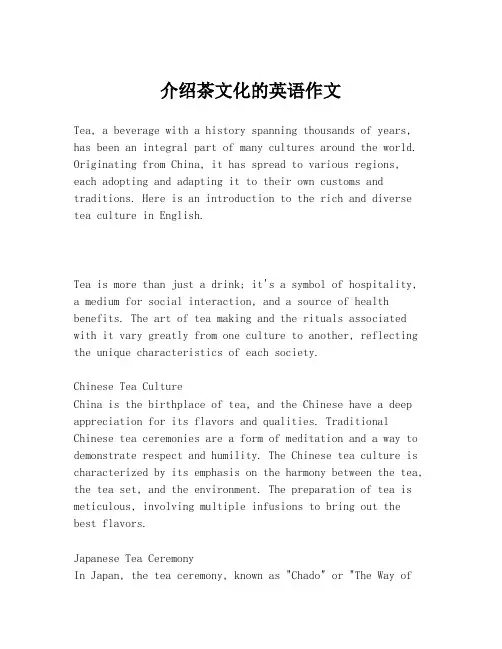
介绍茶文化的英语作文Tea, a beverage with a history spanning thousands of years, has been an integral part of many cultures around the world. Originating from China, it has spread to various regions, each adopting and adapting it to their own customs and traditions. Here is an introduction to the rich and diverse tea culture in English.Tea is more than just a drink; it's a symbol of hospitality, a medium for social interaction, and a source of health benefits. The art of tea making and the rituals associated with it vary greatly from one culture to another, reflecting the unique characteristics of each society.Chinese Tea CultureChina is the birthplace of tea, and the Chinese have a deep appreciation for its flavors and qualities. Traditional Chinese tea ceremonies are a form of meditation and a way to demonstrate respect and humility. The Chinese tea culture is characterized by its emphasis on the harmony between the tea, the tea set, and the environment. The preparation of tea is meticulous, involving multiple infusions to bring out the best flavors.Japanese Tea CeremonyIn Japan, the tea ceremony, known as "Chado" or "The Way ofTea," is a highly ritualized practice that embodiesprinciples of harmony, respect, purity, and tranquility. The ceremony is not just about drinking tea but also about appreciating the beauty of the tea utensils and the aesthetics of the tea room. It is a spiritual journey that promotes mindfulness and connection with nature.British Tea TraditionThe British have a long-standing love affair with tea. The British tea tradition is synonymous with afternoon tea, a light meal typically enjoyed between lunch and dinner. It usually includes a variety of teas, finger sandwiches, scones with clotted cream and jam, and a selection of pastries. Tea in Britain is a social affair, often enjoyed in the company of friends or family.Indian ChaiIn India, tea is known as "chai" and is a staple in every household. Indian chai is typically made with strong black tea leaves, milk, sugar, and a blend of aromatic spices such as cardamom, ginger, and cinnamon. It is often served hot and is a popular beverage to enjoy with snacks or meals.Tea in the Middle EastIn Middle Eastern cultures, tea is often served as a gesture of hospitality. It is common to serve tea in small, clear glasses accompanied by sweets or dates. The tea is usually sweet and can be flavored with mint or other herbs.Health BenefitsTea is known for its numerous health benefits. Green tea, inparticular, is rich in antioxidants that can help combat free radicals and reduce the risk of certain diseases. Herbal teas can also provide a variety of health benefits, depending on the herbs used.ConclusionWhether it's the ancient Chinese tea ceremonies, the meditative Japanese tea ritual, the social British afternoon tea, the spiced Indian chai, or the aromatic Middle Eastern tea, the culture of tea is a testament to its universal appeal. It transcends borders and unites people through a shared love for this simple yet complex beverage.Tea is a drink that invites you to slow down, savor the moment, and connect with others. It is a tradition that has evolved over centuries, and it continues to be a source of comfort, pleasure, and cultural expression for people all around the world.。
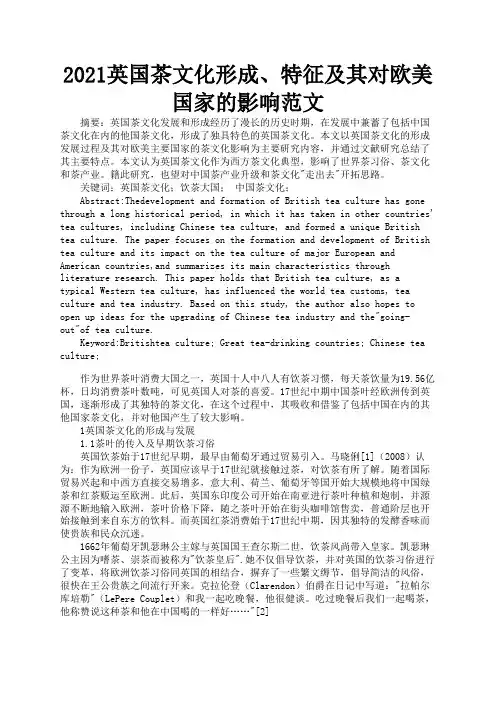
2021英国茶文化形成、特征及其对欧美国家的影响范文 摘要:英国茶文化发展和形成经历了漫长的历史时期,在发展中兼蓄了包括中国茶文化在内的他国茶文化,形成了独具特色的英国茶文化。
本文以英国茶文化的形成发展过程及其对欧美主要国家的茶文化影响为主要研究内容,并通过文献研究总结了其主要特点。
本文认为英国茶文化作为西方茶文化典型,影响了世界茶习俗、茶文化和茶产业。
籍此研究,也望对中国茶产业升级和茶文化"走出去"开拓思路。
关键词:英国茶文化;饮茶大国;中国茶文化; Abstract:Thedevelopment and formation of British tea culture has gone through a long historical period, in which it has taken in other countries' tea cultures, including Chinese tea culture, and formed a unique British tea culture. The paper focuses on the formation and development of British tea culture and its impact on the tea culture of major European and American countries,and summarizes its main characteristics throughliterature research. This paper holds that British tea culture, as atypical Western tea culture, has influenced the world tea customs, tea culture and tea industry. Based on this study, the author also hopes to open up ideas for the upgrading of Chinese tea industry and the"going-out"of tea culture. Keyword:Britishtea culture; Great tea-drinking countries; Chinese tea culture; 作为世界茶叶消费大国之一,英国十人中八人有饮茶习惯,每天茶饮量为19.56亿杯,日均消费茶叶数吨,可见英国人对茶的喜爱。
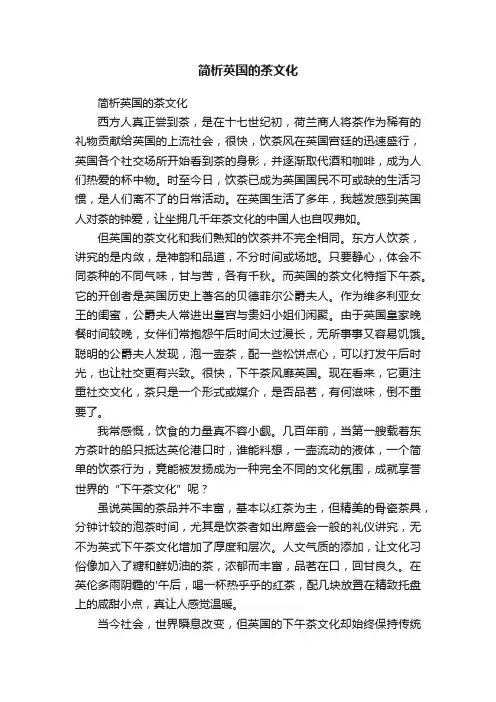
简析英国的茶文化简析英国的茶文化西方人真正尝到茶,是在十七世纪初,荷兰商人将茶作为稀有的礼物贡献给英国的上流社会,很快,饮茶风在英国宫廷的迅速盛行,英国各个社交场所开始看到茶的身影,并逐渐取代酒和咖啡,成为人们热爱的杯中物。
时至今日,饮茶已成为英国国民不可或缺的生活习惯,是人们离不了的日常活动。
在英国生活了多年,我越发感到英国人对茶的钟爱,让坐拥几千年茶文化的中国人也自叹弗如。
但英国的茶文化和我们熟知的饮茶并不完全相同。
东方人饮茶,讲究的是内敛,是神韵和品道,不分时间或场地。
只要静心,体会不同茶种的不同气味,甘与苦,各有千秋。
而英国的茶文化特指下午茶。
它的开创者是英国历史上著名的贝德菲尔公爵夫人。
作为维多利亚女王的闺蜜,公爵夫人常进出皇宫与贵妇小姐们闲聚。
由于英国皇家晚餐时间较晚,女伴们常抱怨午后时间太过漫长,无所事事又容易饥饿。
聪明的公爵夫人发现,泡一壶茶,配一些松饼点心,可以打发午后时光,也让社交更有兴致。
很快,下午茶风靡英国。
现在看来,它更注重社交文化,茶只是一个形式或媒介,是否品茗,有何滋味,倒不重要了。
我常感慨,饮食的力量真不容小觑。
几百年前,当第一艘载着东方茶叶的船只抵达英伦港口时,谁能料想,一壶流动的液体,一个简单的饮茶行为,竟能被发扬成为一种完全不同的文化氛围,成就享誉世界的“下午茶文化”呢?虽说英国的茶品并不丰富,基本以红茶为主,但精美的骨瓷茶具,分钟计较的泡茶时间,尤其是饮茶者如出席盛会一般的礼仪讲究,无不为英式下午茶文化增加了厚度和层次。
人文气质的添加,让文化习俗像加入了糖和鲜奶油的茶,浓郁而丰富,品茗在口,回甘良久。
在英伦多雨阴霾的'午后,喝一杯热乎乎的红茶,配几块放置在精致托盘上的咸甜小点,真让人感觉温暖。
当今社会,世界瞬息改变,但英国的下午茶文化却始终保持传统的内容和礼仪,甚至连搭配的点心也少有改变。
在英国,可能不是每个城镇都有星巴克,但无论在哪里,都能找到享受下午茶的馆子,品尝到风格相近、内容相同的下午茶。
茶文化英文作文100词英文回答:Tea culture is a significant aspect of social life in many countries, particularly in East Asia. Tea has been consumed for centuries and is seen as a symbol of hospitality, friendship, and relaxation.Tea ceremonies are a common way to enjoy tea in East Asia. These ceremonies are often steeped in tradition and can vary depending on the country or region. In China, for example, the tea ceremony is known as gong fu cha and involves a specific set of steps and rituals.Tea has also been used for centuries for medicinal purposes. It is believed to have a number of health benefits, including reducing stress, improving heart health, and boosting the immune system.In the West, tea is often seen as a casual beveragethat is enjoyed at breakfast or as an afternoon pick-me-up. However, tea is also a popular ingredient in cocktails and desserts.Overall, tea culture is a rich and complex traditionthat spans many centuries and cultures. It is a tradition that is still practiced by millions of people around the world today.中文回答:茶文化是许多国家社交生活中不可或缺的一部分,特别是在东亚。
浅析英国茶文化摘要:茶文化是英国文化的重要组成部分,它渗透了英国人民生活的方方面面,具有非常重要的影响力。
本文从英国茶文化的发展历程,茶文化的内涵以及茶文化的社会影响等方面论述英国茶文化。
关键词:茶文化,英国,文化一首英国民谣唱道:“当时钟敲响四下时,世上的一切瞬间为茶而停。
”茶不仅是一种饮品、食品,也是一种艺术品,更是一部文化史、医学史和文学史。
透过茶,我们可以看到一个国家的艺术、文化和文学等。
茶叶从东方到西方,从中国到英国,经历了坎坎坷坷,犹如人生的成长过程,最终日渐成熟。
在英国,茶最初是“药品”,随后上升到贵族的奢侈品,最后才成为必需品国民饮料,进而演变成当今风靡世界的红茶文化。
这一过程虽然漫长但是却增添了英国历史、文化、社会等多方面河流中的美丽。
一、英国茶文化发展历程茶最初作为一种神奇且充满东方魅力的仙草传入英国,开启了英国茶文化的源流。
饮茶之风最初是由英国贵族开启的,并且作为一种与金银同等价值的商品在英国上层社会流通。
因此,英国茶文化是17世纪初英国的贵族阶层开启的。
18 世纪初茶叶开始由贵族富人的饮料向平民开放, 1700 年英国的杂货铺开始出售茶叶就是明证。
18 世纪上半期, 民众对于饮茶已经十分热衷,茶叶消费呈现出逐步上升的趋势。
18 世纪中叶以后, 饮茶逐渐在英国城乡各阶层中普及, 茶叶成为英国人不可缺少的大宗消费品。
1750 年前后, 英国中产阶级黄油烤面包的惯常早餐中已经少不了茶。
甚至伦敦城内,仆人们的早餐也已经基本上是黄油、面包配奶茶十八世纪中叶, 英国人流行的是丰盛的早餐, 午餐则十分简单直到晚上八点钟再进丰盛的晚餐。
由于两餐之间的间隔时间较长, 于是一些贵族妇女开始在下午四、五点钟吃甜点, 然后慢慢地喝茶,聊天、会友, 导致众多妇女争相效仿, 午后饮茶便作为一种上层社会的礼仪逐渐盛行,并迅速普及到平民社会, 逐渐形成了具有鲜明民族特色的英国茶文化。
二、英国茶文化的内涵1.药用价值茶传入英国时,茶的卖点在于它的药性。
介绍茶文化的英语作文1Tea culture is an extremely rich and diverse part of human heritage that has been cherished for centuries all around the world.The origin of tea can be traced back thousands of years. It is believed to have originated in China. Legend has it that Emperor Shen Nong discovered tea accidentally when some tea leaves blew into his pot of boiling water. From China, the cultivation and drinking of tea gradually spread to other parts of Asia and then to the rest of the world.There are a vast number of tea varieties. Green tea, for example, is very popular. It is made through a series of processes. First, the tea leaves are carefully picked, usually by hand to ensure that only the best leaves are selected. Then comes the process of fixation, which stops the oxidation of the leaves. After that, the leaves are rolled to give them their characteristic shape. Finally, they are dried to reduce the moisture content. Black tea, on the other hand, is fully oxidized during its production process. Oolong tea is a semi - oxidized tea, with a unique flavor that lies between green and black tea.The production process of tea is not only a science but also an art. Different regions may have slightly different methods, but the general principles remain the same. For instance, in some areas, traditional techniques are still used to make tea, which have been passed down through generations.When it comes to tea - drinking customs, they vary greatly from place to place. In China, tea has long been an important part of social and cultural life. People often drink tea during family gatherings, business meetings, or just for relaxation. There are also elaborate tea ceremonies in some areas, where every step from brewing toserving the tea is full of etiquette. In the UK, the tradition of afternoon tea is well -known. People usually have tea in the afternoon, often accompanied by sandwiches, scones, and cakes. It is a time for people to relax, chat, and enjoy a break from their daily routine. In Japan, the tea ceremony, known as Chanoyu or Sado, is a highly ritualized form of tea -drinking. It emphasizes harmony, respect, purity, and tranquility.In conclusion, tea culture encompasses a wide range of aspects from its origin, different types, production methods to various tea - drinking customs. It is not just a beverage but also a symbol of different cultures and a way for people to connect with each other and with their traditions.2Tea culture is a profound and fascinating aspect of human civilization that has been developed and cherished in various countries around the world.In China, tea has a long - standing history that dates back thousands of years. Chinese tea culture is not just about drinking tea; it embodies a profound philosophical concept known as the "tea ceremony spirit". This spirit emphasizes harmony, respect, purity, and tranquility. For example, when preparing Gongfu tea, a special type of Chinese tea - making method, great attention is paid to every detail. The choice of tea sets is crucial. Usually, a set of traditional Chinese tea sets includes a teapot, often made of purple clay which is believed to be able to preserve the flavor of tea better. There are also small cups with delicate patterns. The brewing process is an art in itself. First, the tea leaves are carefully selected and rinsed with hot water to clean them and also to awaken their flavor. Then, the appropriate amount of tea leaves is put into the teapot. The water used for brewing is preferably spring water, as it is thought to bring out the best taste of the tea. The water temperature varies depending on the type of tea. For green tea, relatively lower -temperature water is used, while for black tea, hotter water is required. Afterpouring the water into the teapot, the tea is left to steep for a certain period of time. During this time, the aroma of the tea gradually fills the air. Finally, the tea is poured into the small cups in a graceful manner, and people can savor the tea while enjoying the tranquility and the company of friends or family.In Japan, matcha tea culture is very distinctive. Japanese matcha tea ceremony is highly ritualized. It reflects a strong sense of etiquette. The ceremony is carried out in a very specific environment, usually a traditional Japanese - style room with tatami mats. The participants are required to sit in a proper posture. The process of making matcha tea is also elaborate. The matcha powder is carefully measured and placed in a special bowl. Hot water is added gradually while using a bamboo whisk to stir the tea in a specific pattern until it forms a thick, frothy consistency. Every movement during the ceremony, from the way of holding the utensils to the rhythm of stirring the tea, is strictly regulated, showing respect for the tea and the guests.In the United Kingdom, tea is an important part of daily life. Although the British tea culture may not have the same kind of philosophical or highly ritualized elements as in China and Japan, it has its own characteristics. Afternoon tea is a well - known tradition. People usually have tea with various pastries, such as scones, sandwiches, and cakes. The tea is often black tea, which is served with milk and sugar. The British tea - drinking habit is more about relaxation and socializing. It is a time for people to gather, chat, and unwind.In India, tea, especially chai, is deeply ingrained in the local culture. Chai is made with a blend of black tea, milk, spices like cardamom, cinnamon, and ginger. The brewing process involves boiling the tea leaves with the spices and milk together, creating a rich and aromatic beverage. Tea stalls can be found everywhere in India, and drinking chai is a common activity for people at any time of the day, whether it is for a quick break during work or for a social gathering with friends.In conclusion, tea culture in different countries reflects the unique values, traditions, and lifestyles of their respective cultures. It is not only a beverage but alsoa carrier of cultural heritage, a means of communication, and a way to express different forms of beauty and respect.3Tea culture is an integral part of human civilization, with a long and storied history that dates back thousands of years.In ancient times, tea was first discovered in China. Legend has it that Shen Nong, an ancient Chinese emperor, accidentally found the tea leaves when he was boiling water under a tea tree. Initially, tea was used for medicinal purposes. People gradually realized that it had a refreshing effect and could also be used for relaxation. As time went by, tea became an important part of daily life in China. During the Tang Dynasty, tea drinking became a fashion among the aristocracy. Grand tea -making ceremonies were held, and poets often wrote poems about tea, which further promoted the spread of tea culture.The ancient Silk Road also played a crucial role in the spread of tea. Chinese tea was carried along this long - distance trade route. Merchants from different regions would exchange tea with other precious goods. Tea reached Central Asia, the Middle East, and even parts of Europe. This not only introduced tea to the outside world but also made tea an important commodity in international trade. In these foreign lands, people were initially attracted by the unique taste of tea. They gradually incorporated tea into their own cultures, developing different ways of brewing and drinking tea.With the passage of time, the modern era has witnessed a new chapter in tea culture. Globalization has made tea culture spread more widely. Modern transportation and communication technologies have made it easier for tea to reach every corner of the world. Today, we can find various types of tea in supermarkets all over the world, from green tea to black tea, from oolong tea to white tea. In addition, modern tea culture has also incorporated new elements. For example, tea - themedcafes have emerged in many big cities. People can enjoy a cup of fragrant tea while chatting with friends or reading books.Moreover, scientific research has also deepened our understanding of tea. We now know that tea contains various beneficial substances such as antioxidants, which are good for our health. This has further promoted the popularity of tea. In some Western countries, people who used to prefer coffee are now gradually turning to tea. Tea has become a symbol of a healthy lifestyle.In conclusion, tea culture has evolved from its ancient origins in China to a global phenomenon today. It has not only withstood the test of time but also continuously incorporated new elements and adapted to the changing times. It is a wonderful gift from human history that continues to bring people together and enrich our lives.4Tea culture is an integral part of many societies around the world and has a profound impact on people's lives in various aspects.First of all, tea plays a significant role in social interactions. In many countries, especially in Asia, serving and drinking tea is a common way to welcome guests. For instance, in China, when a guest arrives, the host will usually offer a cup of hot tea as a sign of hospitality. People sit around a table, sipping tea and chatting. It is a time -honored tradition that helps to break the ice and build relationships. In Japan, the tea ceremony is a highly ritualized form of social gathering. It is not just about drinking tea but also about the appreciation of art, beauty, and harmony. Through the precise movements and the sharing of tea, participants can communicate with each other on a deeper spiritual level.Moreover, tea has a positive influence on health. Tea, especially green tea, is rich in antioxidants such as catechins. These antioxidants can help to prevent celldamage caused by free radicals in the body. Regular consumption of tea may reduce the risk of certain diseases, like heart disease and some types of cancer. For example, in some studies, it has been found that people who drink tea regularly have a lower incidence of heart problems compared to those who don't. Also, tea contains caffeine which can provide a mild energy boost without the jitters that often come with coffee. It can improve mental alertness and concentration, which is beneficial for people who need to stay focused during work or study.In addition, tea culture also has an impact on the economy. The tea industry provides jobs for a large number of people, from tea growers in the plantations to those working in tea shops and cafes. There are also various tea - related products, such as tea sets, which form a part of the consumer market. The international trade of tea also promotes cultural exchanges between different countries.In conclusion, tea culture is much more than just a beverage. It is a way of life, a form of art, and a means of promoting health and social harmony. It has left a deep mark on human history and continues to be an important part of our modern - day lives.5Tea, a beverage that has been an integral part of human culture for centuries, is far more than just a drink. It embodies a rich and profound cultural connotation that has deep - rooted connections with philosophy, art, and social interactions.In many cultures, especially in Asian ones like China, tea is closely associated with philosophy. The act of preparing and drinking tea can be seen as a form of meditation. For example, the Chinese concept of "harmony between man and nature" is vividly reflected in tea -making. When brewing tea, one needs to pay attention to the quality of water, the temperature, and the time of brewing, which all require a harmonious combination with the natural properties of tea leaves. It is like following the rhythm of nature, and through this process, people can achieve a stateof inner peace and self -reflection, just as philosophers have long pursued the understanding of the self and the world.Moreover, tea has a strong bond with art. In the history of China, numerous literati and poets have been inspired by tea. They often gathered with friends over a pot of tea. In these tea - centred gatherings, the aroma of tea filled the air, creating an atmosphere of tranquillity and inspiration. Poets would compose beautiful verses while sipping tea. Take Lu Yu, the "Sage of Tea" in Chinese history. His work "The Classic of Tea" not only systematically introduced the knowledge of tea, including tea - growing, tea - making, and tea - drinking, but also incorporated his understanding of aesthetics and culture. This work has influenced generations of people's perception of tea, elevating tea from a simple drink to an art form.The social aspect of tea culture is also remarkable. Tea has always been a medium for people to connect with each other. In China, the tradition of "tea as a matchmaker" has been around for a long time. When people want to get to know someone or strengthen relationships, they often invite others to drink tea. During the tea -drinking process, people can exchange ideas, share stories, and deepen their understanding of each other. This kind of communication is gentle and sincere, without the hustle and bustle of modern social interactions.In conclusion, tea culture is a multi -faceted gem in human culture. It encompasses philosophical wisdom, artistic inspiration, and social values. It is a heritage that has been passed down through generations and will continue to be cherished and explored in the future.。
茶文化英语作文初中简单Tea culture is an important part of Chinese tradition.It has a long history and has been deeply integrated into the daily life of Chinese people. Tea culture is not only about drinking tea, but also about the art of making and serving tea, as well as the philosophy and etiquette behind it.First of all, Chinese people have a special way ofmaking and serving tea, which is called "Gongfu tea ceremony". This traditional way of making tea involves a series of precise and delicate steps, such as warming the teapot, rinsing the tea leaves, and pouring the water in a specific order. It requires skill, patience, and attentionto detail. The Gongfu tea ceremony is not only a way of making tea, but also a form of art that reflects the harmony between nature and human.Secondly, tea culture embodies the philosophy of harmony and respect. In Chinese culture, tea is not just a beverage, but a way to connect with nature and find inner peace. The act of making and drinking tea is a way to slow down and appreciate the present moment. It is also a way to showrespect to the guests, as serving tea is a common gesture of hospitality in China.Furthermore, there are many different types of tea in Chinese tea culture, each with its own unique flavor and health benefits. For example, green tea is known for its refreshing and cleansing properties, while oolong tea is famous for its complex and rich taste. Drinking different types of tea can bring different experiences and benefits to the body and mind.In conclusion, tea culture is a significant part of Chinese tradition, and it represents the harmony, respect, and mindfulness that are valued in Chinese philosophy. Through the art of making and drinking tea, people can find a way to connect with nature, cultivate inner peace, and show respect to others. It is a tradition that has been passed down for generations and continues to play an important role in the daily life of Chinese people.茶文化是中国传统文化的重要组成部分。
英文作文茶文化英文,Tea culture is an integral part of my life. Growing up in a Chinese family, tea has always been acentral element of our daily routine. Whether it's a soothing cup of green tea to start the day or a warm pot of oolong tea to accompany a family gathering, tea has always been a symbol of comfort and togetherness for me.One of the most important aspects of tea culture is the art of brewing and serving tea. In Chinese culture, the way tea is prepared and presented is just as important as thetea itself. For example, when serving tea to elders, it is customary to hold the teapot with both hands as a sign of respect. This attention to detail and etiquette is something that has been ingrained in me since I was a child.Another aspect of tea culture that I deeply appreciateis the variety of teas available and the different health benefits they offer. For example, green tea is known forits antioxidant properties and is often touted for itsability to boost metabolism and promote weight loss. On the other hand, oolong tea is believed to aid in digestion and improve mental alertness. The knowledge of these benefits has been passed down through generations, and it's fascinating to see how different teas can have such a positive impact on our well-being.In addition to the health benefits, the act of brewing and sipping tea is also a form of mindfulness for me. Taking the time to prepare a cup of tea and savoring each sip allows me to slow down and appreciate the present moment. It's a simple yet powerful way to practice self-care and find moments of tranquility in the midst of a busy day.Overall, tea culture is not just about the beverage itself, but also about the rituals, traditions, and sense of community that it fosters. It's a way for me to connect with my heritage and find moments of peace and reflectionin a fast-paced world.中文,茶文化对我来说是生活中不可或缺的一部分。